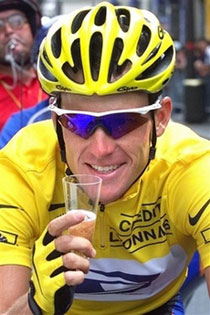
In this July 23, 2000, file photo, seven-time
Tour de France winner Lance Armstrong enjoys a glass of champagne near the
end of another victory. A new but unproven theory says body heat might
explain Armstrong's astounding triumph over testicular cancer. [AP
Photo] |
A new but unproven theory says body heat might explain Lance Armstrong's
astounding victory over testicular cancer. The theory, disputed by Armstrong's
doctor, refers to the unusually high cure rate for testicular cancer, even when
it has spread to other parts of the body.
This form of cancer was highly treatable even before Armstrong was diagnosed
in 1996. However, his public battle with the disease and seven subsequent Tour
de France triumphs put a special spotlight on his recovery.
According to three Johns Hopkins University researchers, the reason for the
good prognosis might have to do with the fact that the temperature of the
testicles is a few degrees cooler than the rest of the body. That's to enhance
development of sperm, but it might also make cancer that develops there
sensitive to heat, the researchers said.
And so, their not-yet-mainstream theory goes, when testicular cancer spreads
to other, warmer body parts, the higher temperature might damage it and render
it more vulnerable to cancer treatment.
Understanding the basis for what they call "the Lance Armstrong effect" might
lead to ways to help make other kinds of cancer more treatable, the researchers
said in an article in Wednesday's Journal of the American Medical Association.
Skeptics include the American Cancer Society's Dr. Michael Thun, who called
the idea "total speculation," and Dr. Craig Nichols, Armstrong's doctor.
"There is no direct or even indirect evidence even remotely supporting this
hypothesis," said Nichols, a specialist at Oregon Health & Science
University's Cancer Institute.
The American Cancer Society estimates that 8,250 men will be diagnosed with
testicular cancer this year. The five-year survival rate is more than 95
percent, even when the disease has spread to nearby lymph nodes, and 72 percent
when it has spread beyond.
Armstrong's disease had spread to his abdomen, lungs and brain. He was
declared cancer-free after treatment that included surgery and chemotherapy.
Nichols said the biological makeup of testicular cancer makes it unusually
sensitive to the cancer drug cisplatin, which has been around for about 30
years.
But the Johns Hopkins researchers, Donald Coffey, Robert Getzenberg and
Dr. Theodore DeWeese, say their theory isn't so far-fetched.
Their article references studies that used heat to treat other tumors,
including cervical cancer. Heat therapy is used in a handful of cancer centers
around the country, and scientists are investigating the best way to selectively
deliver heat to cancer cells. Johns Hopkins is among centers where researchers
are testing potential methods in animals.
Dr. Donald L. Trump, associate director of the Roswell
Park Cancer Institute in Buffalo, NY, said the idea is potentially plausible.
But it's also possible that testicular cancer cells are particularly vulnerable
to stress other than heat. And said Trump, it's worth studying to find
out.